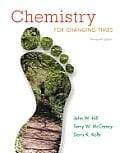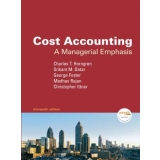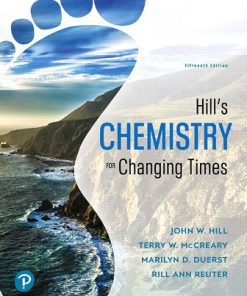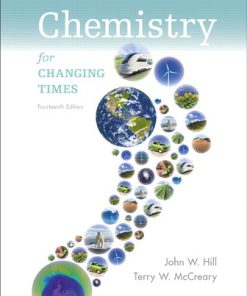Test bank for Chemistry: for Changing Times 13e 0321750101
$35.00 Original price was: $35.00.$26.50Current price is: $26.50.
Test bank for Chemistry: for Changing Times 13e 0321750101
Instant download Test bank for Chemistry: for Changing Times 13e pdf docx epub after payment.

Product details:
- ISBN-10 : 032175087X
- ISBN-13 : 978-0321750877
- Author: John W. Hill; Terry W. McCreary
Table Of Contents:
1 Chemistry
1.1 Science and Technology: The Roots of Knowledge
1.2 Science: Reproducible, Testable, Tentative, Predictive, and Explanatory
1.3 Science and Technology: Risks and Benefit
1.4 Solving Society’s Problems: Scientific Research
1.5 Chemistry: A Study of Matter and Its Changes
1.6 Classification of Matter
1.7 The Measurement of Matter
1.8 Density
1.9 Energy: Heat and Temperature
1.10 Critical Thinking
2 Atoms
2.1 Atoms: Ideas from the Ancient Greeks
2.2 Scientific Laws: Conservation of Mass and Definite Proportions
2.3 John Dalton and the Atomic Theory of Matter
2.4 The Mole and Molar Mass
2.5 Mendeleev and the Periodic Table
2.6 Atoms and Molecules: Real and Relevant
3 Atomic Structure
3.1 Electricity and the Atom
3.2 Serendipity in Science: X-Rays and Radioactivity
3.3 Three Types of Radioactivity
3.4 Rutherford’s Experiment: The Nuclear Model of the Atom
3.5 The Atomic Nucleus
3.6 Electron Arrangement: The Bohr Model (Orbits)
3.7 Electron Arrangement: The Quantum Model (Orbitals/Subshells)
3.8 Electron Configurations and the Periodic Table
4 Chemical Bonds
4.1 The Art of Deduction: Stable Electron Configurations
4.2 Lewis (Electron-Dot) Symbols
4.3 The Reaction of Sodium with Chlorine
4.4 Using Lewis Symbols for Ionic Compounds
4.5 Formulas and Names of Binary Ionic Compounds
4.6 Covalent Bonds: Shared Electron Pairs
4.7 Unequal Sharing: Polar Covalent Bonds
4.8 Polyatomic Molecules: Water, Ammonia, and Methane
4.9 Polyatomic Ions
4.10 Guidelines for Drawing Lewis Structures
4.11 Molecular Shapes: The VSEPR Theory
4.12 Shapes and Properties: Polar and Nonpolar Molecules
5 Chemical Accounting
5.1 Chemical Sentences: Equations
5.2 Volume Relationships in chemical Equations
5.3 Avogadro’s Number and the Names
5.4 Molar Mass: Mole-to-Mass and Mass-to-Mole Conversions
5.5 Solutions
6 Gases, Liquids, Solids…and Intermolecular Forces
6.1 Solids, Liquids, and Gases
6.2 Comparing Ionic and Molecular Substances
6.3 Forces between Molecules
6.4 Forces in Solutions
6.5 Gases: The Kinetic-Molecular Theory
6.6 The Simple Gas Laws
6.7 The Ideal Gas Law
7 Acids and Bases
7.1 Acids and Bases: Experimental Definitions
7.2 Acids, Bases, and Salts
7.3 Acidic and Basic Anhydrides
7.4 Strong and Weak Acids and Bases
7.5 Neutralization
7.6 The pH Scale
7.7 Buffers and Conjugate Acid-Base Pairs
7.8 Acids and Bases in Industry and in Daily Life
8 Oxidation and Reduction
8.1 Oxidation and Reduction: Four Views
8.2 Oxidizing and Reducing Agents
8.3 Electrochemistry: Cells and Batteries
8.4 Corrosion and Explosion
8.5 Oxygen: An Abundant and Essential Oxidizing Agent
8.6 Some Common Reducing Agents
8.7 Oxidation, Reduction, and Living Things
9 Organic Chemistry
9.1 Organic Chemistry and Compounds
9.2 Aliphatic Hydrocarbons
9.3 Aromatic Compounds: Benzene and Its Relatives
9.4 Halogenated Hydrocarbons: Many Uses, Some Hazards
9.5 Functional and Alkyl Groups
9.6 Alcohols, Phenols, Ethers, and Thiols
9.7 Aldehydes and Ketones
9.8 Carboxylic Acids and Esters
9.9 Nitrogen-Containing Compounds: Amines and Amides
10 Polymers
10.1 Polymerization: Making Big Ones Out of Little Ones
10.2 Polyethylene: From the Battle of Britain to Bread Bags
10.3 Addition Polymerization: One + One + One + … Gives One!
10.4 Rubber and Other Elastomers
10.5 Condensation Polymers
10.6 Properties of Polymers
10.7 Plastics and the Environment
11 Nuclear Chemistry
11.1 Natural Radioactivity
11.2 Nuclear Equations
11.3 Half-Life and Radioisotopic Dating
11.4 Artificial Transmutation
11.5 Uses of Radioisotopes
11.6 Penetrating Power of Radiation
11.7 Energy from the Nucleus
11.8 Nuclear Bombs
11.9 Uses and Consequences of Nuclear Energy
12 Chemistry of Earth
12.1 Spaceship Earth: Structure and Composition
12.2 Silicates and the Shapes of Things
12.3 Carbonates: Caves, Chalk, and Limestone
12.4 Metals and Their Ores
12.5 Salts and “Table Salt”
12.6 Gemstones and Semi-Precious Stones
12.7 Earth’s Dwindling Resources
13 Air
13.1 Earth’s Atmosphere: Divisions and Composition
13.2 Chemistry of the Atmosphere
13.3 Pollution through the Ages
13.4 Automobile Emissions
13.5 Photochemical Smog: Making Haze While the Sun Shines
13.6 Acid Rain: Air Pollution Water Pollution
13.7 The Inside Story: Indoor Air Pollution
13.8 Stratospheric Ozone: Earth’s Vital Shield
13.9 Carbon Dioxide and Climate Change
13.10 Who Pollutes? Who Pays?
…
People also search:
|
chemistry for changing times 13th edition pdf
|
chemistry for changing times 13th edition
chemistry for changing times
chemistry for changing times 13th edition ebook
chemistry for changing times 13th pdf
You may also like…
Solution Manual
Solution Manual for Chemistry for Changing Times, 14th Edition John W. Hill Terry W. McCreary












